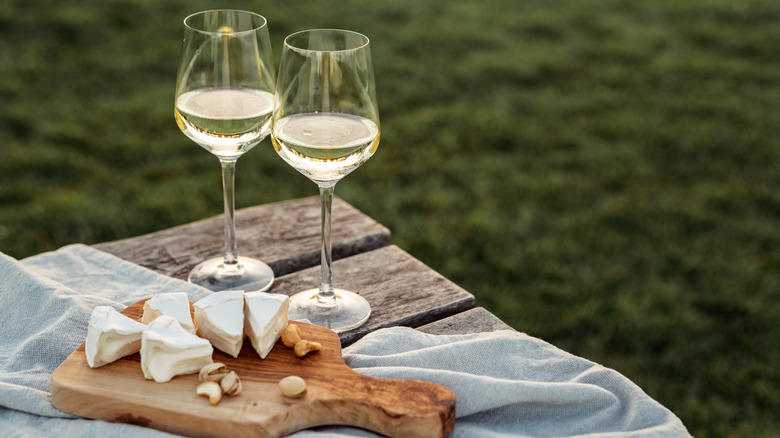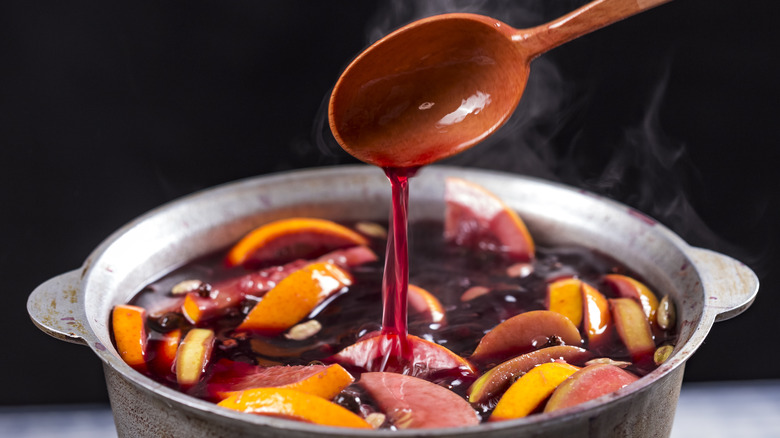What Makes Acid So Important In Wine Pairings
When you're first swirling that savory glass of Merlot, you may think of some conventional pairings that would match its smooth, robust flavor. Wine Enthusiast suggests that chicken, beef, roasted vegetables, and sautéed mushrooms would enhance the wine's black cherry and vanilla undertones. And when it's served at just the right temperature, wine has the power to transform an everyday dinner into a fine dining experience.
But what if it's Taco Tuesday, and all you're craving is spicy chicken tacos? Would the simple bottle of Merlot still work its same magic? Surprisingly, yes. Though it is uncommon and a tad unusual, this fruity, full-bodied wine perfectly balances out the spicy nature of the dish without becoming too overbearing. The same goes for fried chicken and Sauvignon Blanc, an unlikely duo we love to see together.
Despite the seemingly random pairings, there's a science behind this madness that can help you match your wine with whatever foods you have on deck.
Why wine and food pairings are magical
Wine's acidity has a significant effect on the foods we pair it with. It's important to match the flavor of your dish with the acidic profile and body of your wine, and vice versa. Too little or too much, and your dinner can become overly bitter, or it can completely wash out the complexities of your wine. The goal is not to make the two flavors compete but to complement each other.
Let's use tomato-based pasta as an example. Because this dish has a high pH level from its heavy use of tomatoes and, most likely, red meat, you want a wine that matches the power of these two flavors. Wine Folly suggests incorporating a medium-bodied dry red wine, such as Chianti, that will enhance the meat and tomatoes and has an alcohol content between 12.5 and 13.5%.
This knowledge can also be applied to the popular and ancient pairing of wine and cheese. Remember that scene in Disney's "Ratatouille" when Remy tried a slice of cheese and strawberry simultaneously and was immediately surrounded by a wave of color? This is because acidic fruits, such as grapes or strawberries, can match the intensity of the cheese's rich, bitter taste and add a spike of sweetness to the experience, as Usual Wines explains. The same can be said for pairings like bold red wine and gouda cheese or Sauvignon blanc and muenster.
Fruity acids are responsible for tart wine
According to Science of Cooking, tartaric, malic, and citric are the three primary acids that give wine its signature tart taste. Tartaric acid, the most prominent acid that stems from many fruits, such as grapes and cherries, can help reduce and control acidity levels in wine (per Home Brew It). It is what gives the wine its sharp flavor and helps maintain its extended shelf life.
Now, picture malic acid as a green apple. Both have the same sour taste and can be transformed into other items, including everything from apple pie to skincare products, per Healthline. When alcohol is fermented, a small amount of this chemical can be metabolized and reduce the pH level of the wine. However, it is much less prominent than tartaric acid. Last is citric acid, which can also be fermented and is primarily used in white or pink wines.
Wine varies on the pH scale. The more acidic the wine is, the more you may pucker or salivate at its profile. Riesling and other sparkling white wines have a pH level below or at three (similar to citric juice or soda). In contrast, robust reds like Cabernet Sauvignon rest at a near 4 (per Wine Folly). A low acidic profile makes this a creamier, rich wine that can be paired with foods like filet mignon and tuna.
When to use wine in the kitchen
Ever wondered what the red wine vinegar in the back of your pantry was made of? Well, it partly comes from the process of oxidation, when wine takes on a more vinegary taste from air exposure. Though there isn't necessarily an expiration date on wine, oxidation begins once oxygen changes the chemical composition of alcohol in wine, according to Wine Enthusiast. (It's also what naturally happens to fruits and vegetables that have been out for too long.)
After a few days of this exposure, the wine may have a different smell or taste that varies from its initial presentation. However, don't let this phenomenon deter you. It could be the ideal addition missing from your meal.
There are many ways to put oxidized wine to use. Life Hacker states that oxidized red wine can be an effective way to tenderize meat or to deglaze a pan. You can also use it to braise meat, create a sauce, marinate foods, or make a homemade vinaigrette dressing, suggests VinePair. You can even take it out of the kitchen and make it into a fly trap, dye clothes, or use it as a disinfectant. Like the number of brands and bodies of wine, the options are limitless.



